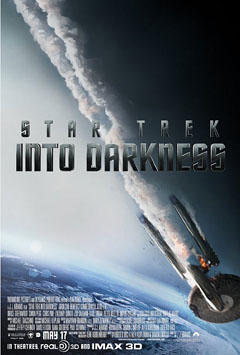Review: Star Trek Into Darkness
I n 2009, J.J. Abrams accomplished the impossible and successfully negotiated an unwinnable scenario by rebooting the Star Trek franchise with a new cast in a story that maintained continuity -- yet also broke somewhat -- with the establish Trek universe. This reset gave him license to play with the characters in entirely new ways; for instance, the relationship between Uhura and Spock. With the newly released Star Trek Into Darkness, Abrams plays with the entire character of the Federation itself, playing out logically the results of events that created his alternate universe and arriving at a colder, harder conclusion that doesn't sit well with many hardcore fans.
n 2009, J.J. Abrams accomplished the impossible and successfully negotiated an unwinnable scenario by rebooting the Star Trek franchise with a new cast in a story that maintained continuity -- yet also broke somewhat -- with the establish Trek universe. This reset gave him license to play with the characters in entirely new ways; for instance, the relationship between Uhura and Spock. With the newly released Star Trek Into Darkness, Abrams plays with the entire character of the Federation itself, playing out logically the results of events that created his alternate universe and arriving at a colder, harder conclusion that doesn't sit well with many hardcore fans.
Based on his Daily Show appearance this week, in which Abrams explained his goal was to make a movie for moviegoers and not just Star Trek fans, some have said he is only concerned with his film making as much money as possible. My own feeling was that Abrams again succeeded in bringing to life a story that is true to the characters on the Enterprise, but a disturbing departure from Gene Roddenberry's vision of The United Federation of Planets.
This is not the first time Trek fans have seen a darker vision of the future: The clandestine agency known as Section 31 mentioned in Star Trek Into Darkness has appeared a number of times in the various TV shows, which have also hinted at a much darker future for the Federation in centuries to come.
But the events on screen now, in this movie, are the darkest we've seen for the classic Trek characters, aren't they? As much as we might want to blame the effects of Christopher Nolan's Batman films for the darkening of comic-book and sci-fi films, there is precedent for a darker side of the Federation scattered through classic episodes. A 13-year-old Jim Kirk witnessed the massacre of 4,000 colonists by Governor Kodos during a food shortage on Tarsus IV (episode "The Conscience of the King"). The Federation also was known to have violent criminals and treated the criminal behavior as a sickness to be cured via therapy in one of several installations known as asylums ("Whom Gods Destroy").
It is also very well established that pre-Federation history included a series of wars that nearly destroyed civilization on Earth, and that but for the civilizing influence of the Vulcans, the UFP would have been a much more warlike body. In fact, classic Trek includes a mirror universe in which events did play out differently, resulting in a fleet where starship captains murder their way into command.
Roddenberry, however based the UFP on an idealistic view of 1960s America and set the tone of the show to match. Harlan Ellison's original script for "The City on the Edge of Forever" included a character abusing drugs, but that's replaced in the episode as shot by Dr. McCoy suffering from a fevered disease instead of withdrawal symptoms.
Star Trek Into Darkness is now Abrams' universe, and he has based this movie on a post-9/11 America where fear, not idealism, is the larger motivating factor. In the post-Nero Federation of the 2009 Star Trek, the Starfleet admiralty was motivated by attacks by Nero both when Kirk was born and decades later, including the destruction of Vulcan, one of the two planets that founded the UFP. The destruction of the Klingon moon Praxis has also increased the empire's hostility, making obvious the need for advanced weaponry and ships.
The use of "Into Darkness" in the title may very well be a signal from Abrams that his Federation is to become the "Dark Mirror" of Roddenberry's world. The story is full of role-reversals beyond the militarization of Starfleet. Benedict Cumberbatch is introduced as John Harrison, a mysterious terrorist figure who is not what he seems, and the central theme is of Kirk (Chris Pine) and Spock (Zachary Quinto) exchanging places, mirroring, roles reversed, as related to events we've seen in the original Star Trek universe.
There is so much to love in this movie, which begins with Kirk true to form breaking the Prime Directive not to interfere with alien cultures. The wordplay between Kirk, Spock, and Pike in the post-mission debriefing is a moment where Abrams perfectly captures the characters as we know and love them. Kirk's hubris as he points out to Pike that he's never lost a crew member will shortly be punished as the Enterprise takes the worst beating it has ever received, though no self-destruct is ever used. That's one missing reference, but so many others appear -- Tribbles, Carol Marcus, Harry Mudd, the Daystrom Institute, Section 31, the Kelvin, Transwarp equations, the Vulcan nerve pinch -- some in passing and some important plot points.
As much as I loved this trek into darkness, some things in the movie fell flat for me. Michael Giacchino's score sounded too recycled from 2009. Though Klingons appear, all except one are wearing armor, a move that probably saved Abrams an enormous makeup budget -- but I didn't at all care for the look of that one unarmored Klingon. It bore only passing resemblance to the established look of the race. Nobody besides Kirk and crew does anything to stand up to the obviously psychopathic antagonists even after hearing their full confessions, and the neutral zone and Klingon homeworld are almost entirely unguarded during a time it has been made clear that war is imminent.
My biggest complaint is with the Lucasization of Trek. Abrams wanted a more action-oriented film, as opposed to the generally more cerebral pace of Star Trek. He's filled the bridge crew with a variety of alien species and takes us from one action set to the next at a frenzied pace. A climactic confrontation takes place midair as characters fight atop flying cars, jumping from one to the next in a scene straight out of the Star Wars prequels.
Star Trek Into Darkness ends with the crew beginning the Enterprise's first five-year mission. In two movies, Abrams has reset the story, established his control and put in place the framework of a more powerful military Federation. The speech at the film's end would seem to be an attempt to unravel some of that and represent a less hostile Starfleet, but if so, it does too little too late. There has been enough rehashing of old material. Moving into a third film, Abrams will need to come up with new ideas and a story that inspires hope and a love of space and exploration if he wants to keep the spirit of Star Trek alive and prosperous.

